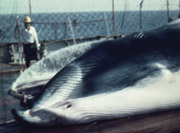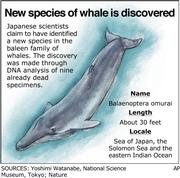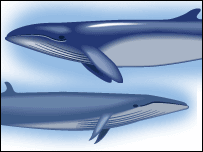|
Yamada, Wada, and Oishi compared the morphology, bone structure, and mitochondrial DNA of the eight specimens killed by the Japanese researchers in the 1970s with that of one whale that washed ashore a coastal island in the Sea of Japan in 1998.
As a whole, the researchers determined from outside appearance this group of specimens most closely resemble a smaller version of the fin whale (B. physalus), but owing to differences in skull shape, baleen plates, and DNA they concluded that the group represents a new species of baleen whale, B. omurai.
According to the description in Nature, B. omurai has an adult body length of less than 40 feet (12 meters) long, a relatively broad and flat skull, and a mouth that tapers from its base.
Based on morphological differences, the researchers also concluded that Bryde's whale and Eden's whale are distinct from each other as well as distinct from the new species, B. omurai.
Baker said that analysis of DNA from the B. edeni holotype specimen in Calcutta and morphological examination of additional specimens would be important to confirm the new taxonomy.
Yamada's team was not able to obtain a DNA sample of the B. edeni specimen in Calcutta but instead used DNA from a matching specimen at the National Museum of Natural History, in Leiden, Netherlands.
"They are basically making the argument that the edeni holotype is different from the new species, omurai. If that is right, the proposal to name the new species is valid," said Baker, who added that regardless of the nomenclature, the clarification of the species-level differences is biologically sound and important for conservation.
|



